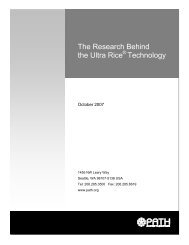Nepal Clean Home Delivery Kit: Evaluation of the Health Impact - Path
Nepal Clean Home Delivery Kit: Evaluation of the Health Impact - Path
Nepal Clean Home Delivery Kit: Evaluation of the Health Impact - Path
Create successful ePaper yourself
Turn your PDF publications into a flip-book with our unique Google optimized e-Paper software.
Table 2. Type <strong>of</strong> birth attendants, by kit use and district<br />
KIT USER<br />
KIT NON-USER<br />
Siraha Morang Sunsari Total Siraha Morang Sunsari Total<br />
Trained TBA 132 121 141 394 168 113 97 378<br />
% 96.4 91.7 93.4 93.8 96.6 89.0 94.2 93.6<br />
<strong>Health</strong> worker 5.0 11 10 26 6 14 6 26<br />
% 3.6 8.3 6.6 6.2 3.4 11.0 5.8 6.4<br />
Total Trained 137 132 151 420 174 127 103 404<br />
Untrained TBA 46 64 65 175 47 78 60 185<br />
% 79.3 45.4 32.7 44.0 38.2 41.5 47.2 42.2<br />
Family/neighbor 12 77 134 223 76 110 67 253<br />
% 20.7 54.6 67.3 56.0 61.8 58.5 52.8 57.8<br />
Total Untrained 58 141 199 398 123 188 127 438<br />
From Tables 3 and 4 on characteristics <strong>of</strong> <strong>the</strong> households and <strong>the</strong> mo<strong>the</strong>rs, it is apparent<br />
that kit users and non-users as a whole do not differ greatly. More users are literate and in<br />
<strong>the</strong> higher socioeconomic category, but generally <strong>the</strong> differences between those with<br />
trained and untrained attendants are greater than those between kit users and non-users. In<br />
particular, <strong>the</strong>re are some significant differences between kit users with trained and<br />
untrained attendants. <strong>Kit</strong> users with a trained birth attendant had:<br />
• Higher proportion <strong>of</strong> female head <strong>of</strong> household.<br />
• More heads <strong>of</strong> household who were 50 years or older.<br />
• Higher literacy rate for head <strong>of</strong> household and for mo<strong>the</strong>rs.<br />
• Higher land ownership rate.<br />
• Higher proportion in mid-level socioeconomic status.<br />
• Younger mo<strong>the</strong>rs.<br />
• More first pregnancies, fewer with five or more pregnancies.<br />
• More mo<strong>the</strong>rs with antenatal care and with tetanus immunization.<br />
Because <strong>of</strong> <strong>the</strong>se differences and <strong>the</strong> possibility that some <strong>of</strong> <strong>the</strong>m may be related to<br />
infection outcome, it was apparent that it might not be possible to pool <strong>the</strong> two groups <strong>of</strong><br />
kit users during <strong>the</strong> analysis. Although <strong>the</strong>re were only minor differences between <strong>the</strong><br />
characteristics <strong>of</strong> <strong>the</strong> two groups <strong>of</strong> kit non-users (more households headed by <strong>the</strong> fa<strong>the</strong>rin-law<br />
ra<strong>the</strong>r than <strong>the</strong> husband and consequently more household heads who were 50<br />
years or older), <strong>the</strong>y differed substantially in birth practices (see below). The differences<br />
in antenatal care and tetanus toxoid (TT) were clearly related, since those with no<br />
antenatal care were much more likely to have no TT (57.6% vs. 9.4%).<br />
Table 3. Household characteristics, by cohort<br />
9<br />
<strong>Nepal</strong> <strong>Delivery</strong> <strong>Kit</strong> <strong>Evaluation</strong> May 2000
















